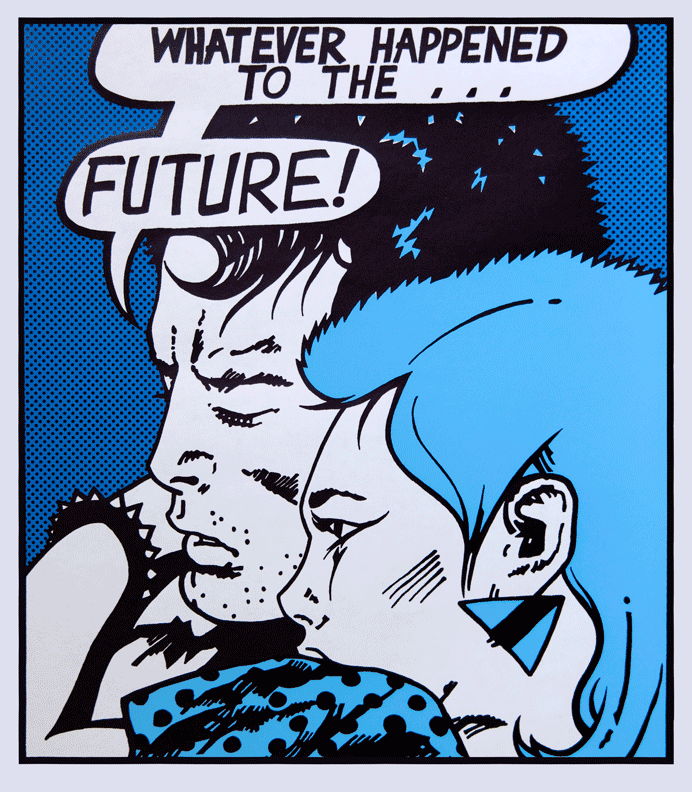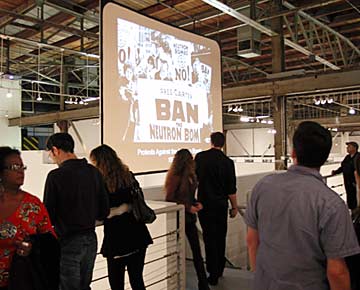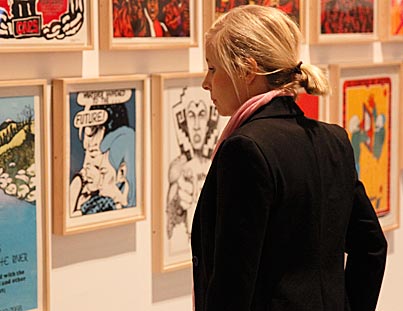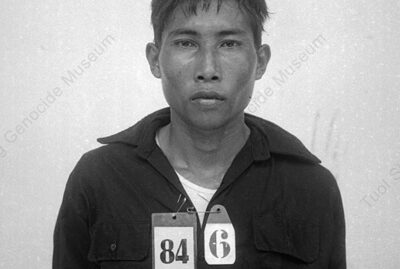Vallen: Under the Big Black Sun
My 1980 silkscreen print, Whatever Happened To The Future!, is included in Under the Big Black Sun: California Art 1974-1981, at the Geffen Contemporary at the Museum of Contemporary Art (MOCA), Los Angeles. My print was created at the height of the Cold War when nuclear war with the Soviet Union seemed a distinct possibility. Originally conceived as a street poster, I fly-posted my print on L.A. avenues in 1980 and gave it away at antiwar protests in the city. Eventually the print was reproduced as a cover for the L.A. Weekly newspaper in the year of the poster’s creation, extending the distribution of the image across the nation.

Signed copies of Whatever Happened To The Future! can be directly purchased here. In addition my print appears in the illustrated exhibition catalogue for Under the Big Black Sun, which also features essays by art critics and historians, Francis Colpitt, Thomas Crow, Charles Desmarais, Peter Frank, and MOCA’s chief curator Paul Schimmel.
Mr. Schimmel wrote that the exhibit; “addresses the dynamic period in American art when modernism, characterized by a master narrative of progress and succession, reached a dead end, and a multiplicity of movements, forms, and genres began to take shape simultaneously.” The exhibit’s name might sound familiar to fans of early 80’s L.A. punk rock. Schimmel, explains why; “The exhibition borrows its title from an album by the Los Angeles–based punk band X to suggest that, during this post-Watergate, post-Vietnam era, disillusionment had eclipsed ‘California Dreamin’ and hippie optimism. The title also alludes to the plethora of individual art practices, both studio and poststudio, that flourished within this dystopian atmosphere, creating an artistic milieu in which ‘everything under the sun’ was permitted and produced.”
When I produced the Whatever Happened To The Future! print I was deeply involved in the late 1970s punk movement, an experience that had enormous impact on my political and aesthetic views. In fact, I was in the midst of creating a number of paintings and drawings on the theme of L.A. punk when I briefly shifted gears to design Whatever Happened. In essence I am a social realist painter and draftsman, and on a personal level the most fulfilling work I do is in that sphere, so in retrospect I feel somewhat ambivalent about the Whatever Happened print. It was unquestionably imbued with punk aesthetics, but it was also influenced by the philosophy of the Situationists (more on that later).
The impetus to create Whatever Happened To The Future! came from a long train of events. As a child in the 1950s the arms race between the U.S. and the Soviet Union was in full swing; I literally grew up with the atomic bomb as it had become emblematic of American power. As a teenager in the late 1960s I became a peace activist opposed to atomic weaponry, but by the late 1970s the arms race had relentlessly escalated to the point where it seemed only a matter of time before either the U.S. or the Soviets would launch atomic Armageddon. Here I might add that in 1978 one of my favorite L.A. punk bands, The Weirdos, released an incendiary single titled We’ve Got The Neutron Bomb, a searing indictment of U.S. militarism; two years later I would create my silkscreen print.
As previously mentioned, in the late 1970s I began reading the theoretical tracts of the Situationist International, a small group of disaffected artists and left intellectuals active in Europe (mostly France) from the late 1950s to the early 1960s. The Situationists influenced a number of the more politically minded punks and artists of the late 1970s, and while I never fully subscribed to their beliefs, I found some of their ideas intriguing. Their stance that “art must not only be critical in its content, it must also be self-critical in its form”, had great appeal to me at the time; it meshed perfectly with punk aesthetics. The Situationists advocated “détournement”, i.e., “the reuse of preexisting artistic elements in a new ensemble” for the purpose of “turning expressions of the capitalist system against itself.” A Situationist analysis of culture, combined with the apocalyptic vision of punk, led to my creating Whatever Happened To The Future!
There is little doubt in my mind that Situationist philosophy influenced performance and conceptual art, but today’s postmodern artists use the Situationist method of détournement uncoupled from its guiding political principle of subversive quotation. Postmodernists generally avail themselves of the Situationist détournement roadmap but have discarded the compass (Richard Prince comes to mind), so the road they travel endlessly loops back to art that exists solely as an adjunct to power, privilege, and profit, the triumvirate Situationists sought to end.

A sprawling multi-faceted exhibition, Under the Big Black Sun gives some insight into the period it covers, and I found the exhibit more engaging and insightful than expected.
There is a gloomy undercurrent to many of the installations, photographs, videos, and conceptual pieces that dominate the show; MOCA providing context for the art by projecting large-screen slideshows throughout the exhibit space that display bleak images from the era; carnage in Vietnam; the assassination of Harvey Milk; the Three Mile Island nuclear accident, etc. Painting receives short shrift in this exhibit, reflecting the postmodern clarion call that “painting is dead.”
Assembled works in the exhibit address a multitude of concerns – from consumerism, urban life, American history and militarism, to issues of racial, gender, and cultural identity. A number of works in the exhibit are well thought out and skillfully executed, while others are intentionally artless, exasperatingly incomprehensible, and narcissistically inward looking. Taken as a whole the exhibit leaves one with the impression that the late 1970s and early 1980s were a time of dissolution and entropy, which was certainly true, but the weakness of the show is that it provides no real understanding of the socio-economic factors behind such a radical shift in aesthetics. To be fair, mounting such a vast exhibit is a considerable undertaking, and Mr. Schimmel has barely scratched the surface of a historic period just beginning to be understood.

As a nexus for artists of various backgrounds to experiment with subversive aesthetics, California’s early punk rock milieu offered unique terrain.
Under the Big Black Sun presents a barebones look at the phenomenon, starting with punk’s confrontational graphic design, represented in the exhibit through flyers, posters, and extant copies of punk magazines like Slash, Search & Destroy, and Flipside. I worked at Slash for a time, creating drawings that appeared as cover art for two separate editions (works not included in the MOCA exhibit).
The San Francisco-based Target Video project of Joe Rees and Jill Hoffman documented some of the first West coast punk bands, and a small screening room in the MOCA exhibit projects live performances captured by Target of the Screamers, Weirdos, Dils, Avengers, X, Mutants, and others. The Los Angeles punk scene was also a testing ground for performance art, and the MOCA show presents a short video of The Kipper Kids (Martin von Haselberg and Brian Routh), who were closely associated with the early L.A. punk explosion. Mark Pauline was well known in early punk circles for his bizarre robot machines, the first of which MOCA has on display.

My Whatever Happened To The Future! print is appropriately situated amongst the posters and drawings MOCA defined as “engaging in social dissent and political protest”.
Vibrantly colorful, unabashedly activist in orientation, and sometimes confrontational, these works condemn war, racism, and state violence, rally the public to collective action against injustice, and encourage viewers to become part of a people’s movement to expand and deepen democracy. Displayed are posters from collectives like La Raza Silkscreen Center and Fireworks Graphics, as well as prints by artists Malaquías Montoya, Carlos Almaraz, Rachael Romero, and Rupert García (García will appear at MOCA on Thursday, Dec 8, at 6:30 pm, to discuss his work – the event is free with museum admission).
The overtly political prints and drawings mentioned above are incongruously out of sync with Paul Schimmel’s supposition that “(….) modernism, characterized by a master narrative of progress and succession, reached a dead end.” As the fly in the postmodern ointment, I must point out that the artworks in question reveal neither a shortage of optimism, nor lack of certitude that a united citizenry armed with the truth can create a better world; which is antithetical to the postmodernist view of there being no objective truths or linear historical development.
Paul Schimmel makes his case that “what cohered as postmodernism during the 1980s in New York effectively codified ideas and concepts evolving from art made in California between 1974 and 1981”. Nevertheless, one might also make the argument – as does cultural critic Fredric Jameson – that postmodernism, as “the cultural dominant of the logic of late capitalism”, marks the alleged triumph of “commodification over all spheres of life”. It is typified by depthlessness and affectlessness, a loss of historicity, a fascination with the “‘degraded landscape of schlock and kitsch”, and as a product of the spectacle society of multinational capitalism, it is “catastrophe and progress all together.”
As if to make my point, that “master narrative of progress and succession”, otherwise known as the material force of history, is in effect knocking at MOCA’s front door. Tens of millions of Americans are without work, have no health insurance, or have lost their homes to bank foreclosures as social conditions in the U.S. worsen. While Under The Big Black Sun opened to the public, the Occupy Wall Street protest movement was just beginning in New York’s financial district. As I write this, the anti-plutocracy demonstrations have now spread to over 100 U.S. cities, with a major encampment ensconced on the grounds of Los Angeles City Hall, just a few blocks from MOCA. How artists in part responded to the social crisis of late 1970s America can to a certain extent be viewed at Under the Big Black Sun. The question for today is, in what manner will American artists respond to the biggest economic collapse since the 1930s?
Whatever Happened To The Future? It remains to be created by all of us.
Under the Big Black Sun: California Art 1974-1981 runs at the Geffen Contemporary at the Museum of Contemporary Art (MOCA) from October 1, 2011 through February 13, 2012. The Geffen is located at 152 N. Central, Los Angeles, CA 90012. Phone: 213-626-6222.




